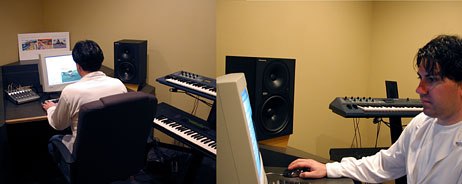Mark Simon continues his series of 12 excerpts from his new book, Producing Independent 2D Character Animation: Making and Selling a Short Film.

All images are from Producing Independent 2D Character Animation: Making and Selling a Short Film, by Mark Simon. Reprinted with permission.

Steven Bak working on the sound effects for Lesson 3.
This is the ninth in a series of 12 excerpts from Mark Simons book, Producing Independent 2D Character Animation: Making and Selling a Short Film. This book is a full-color, concept-to-pitch guide that teaches animators, students and small studios the art and business of producing short, cel animated films. Animation producer Mark Simon has detailed the process in an accessible how-to manner using his award-winning series, Timmys Lessons In Nature, as a guide. This 432-page book contains more than 600 full-color images, interviews and a CD-ROM containing sample animation, animatics and sample software described in the text.
Music and sound effects are the final touches that give your project life. The right music can help your animation flow, and sound effects can give your work a solid feeling that adds to the illusion of life.
If you are lucky enough either to afford an outside audio house or to make a deal with one to provide you with music and sound effects, they will need the final edit of your animation to work with. Try to make sure that you dont give an audio house a video file that does not have a locked edit, or the work they do might be a waste of time. Any timing changes you make in the video will throw off the audio timings. Check with the audio facility as to the format in which they would like to receive your video. They may ask you to provide them with a low-resolution .mov file or a simple VHS tape to work with. They will, in turn, provide you with an audio file that you drop into your edit suite.
On the third episode of Timmys Lessons in Nature, we had an Orlando music and sound design company, Sound O Rama, produce the music and sound effects. We provided Sound O Rama with a 320x240dpi .mov file of the final edit. They came up with a few samples of music for us based on the style of music we asked for. They then produced a custom music track that supported the action in our short. They added all the sound effects, from the chirping of the squirrel in the opening credits, to the vicious attack of the rabid fox. During the audio production, I would go to the studio and make notes as to what sounds I liked and what sounds needed to be enhanced. Once their work was done, they provided us with a stereo .wav file that we dropped into our Premiere [Adobe] edit suite.
On the first two episodes of Timmys Lessons in Nature we produced all the music and sound effects in-house. We used a program called SmartSound to build the music. SmartSound also has a professional version that allows you many more options when building a music score, including importing the video. Its software builds music according to the length of time you specify, the style of music you want, and a number of other options. The quality of the music is wonderful, and its very easy to use.
Another music production software is Acid [Sonic Foundry]. With Acid, you not only determine what type of music you want, you actually build the different levels of instruments until youre happy. Acid is often used for the Internet and for presentations where music loops are needed.
Lesson 3 had professionally produced original music. Kays Al-Atrakchi of Sound O Rama wrote and composed the music using the music composing software, Digital Performer [MOTU]. We would sit down together and watch the animation while listening to his music. I made comments on the feelings I wanted to portray and where I felt the important beats were, and he also made suggestions as to what he thought would work best. He adjusted his music to rise and fall along with the action. Using Digital Performer, Kayswould lay in all the instruments, one at a time, using his piano keyboard. The software captured the music and allowed him to edit the music in any way he wanted. He then exported the music as a digital file to be edited in with the other sound effects.
The remaining chapter describes creating the sound effects and adding the music and sounds to the final edit. To learn about other topics, check out Producing Independent 2D Character Animation, published by Focal Press. It can be bought at any bookstore or online.
Producing Independent 2D Character Animation: Making and Selling a Short Film, by Mark Simon. Burlington, Massachusetts: Focal Press, 2003. 432 pages. ISBN: 0-240-80513-5.

Mark Simon founded and owns A&S Animation, Inc., an award-winning cel animation house in Florida, which develops and produces character animation for commercials, TV, training videos and the Web. He also owns Animatics & Storyboards, Inc., the largest storyboard house in the southern United States, which has provided work on more than 1,200 productions. Marks accomplishments include owning an award-winning advertising firm, being a syndicated cartoonist, production designer of film and TV, writing entertainment industry books and lecturing on both animation and storyboards. Winning more than 30 animation awards for his efforts, Mark has directed Timmys Lessons In Nature (which he sold as a TV series), My Wife Is Pregnant, numerous commercials, training videos and television series special effects.












